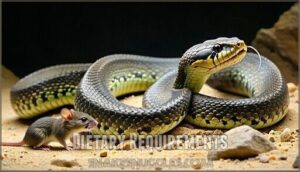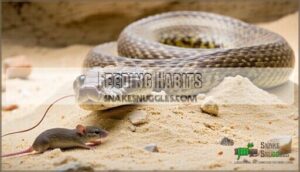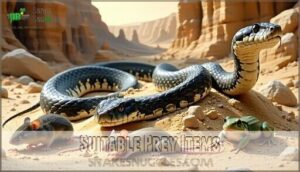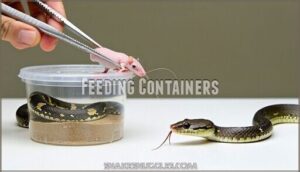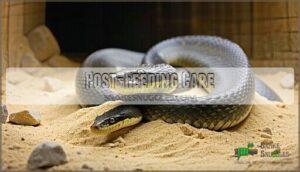This site is supported by our readers. We may earn a commission, at no cost to you, if you purchase through links.
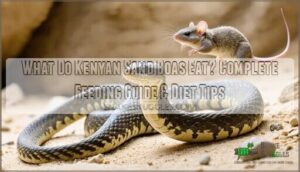
You’ll feed juveniles appropriately-sized prey every 5-7 days, while adults eat every 10-14 days.
The mouse should be roughly the same width as your snake’s thickest body section, and these ambush predators don’t need live prey.
Frozen mice provide all necessary nutrients without the risk of injury, and you can thaw mice by placing them in a plastic bag submerged in warm water for 20-30 minutes.
Your snake’s feeding response might surprise you with its lightning-fast strike and powerful constriction abilities.
Table Of Contents
Key Takeaways
- You’ll feed your Kenyan sand boa frozen-thawed mice as their complete diet – juveniles every 5-7 days, adults every 10-14 days, with prey matching your snake’s thickest body section width.
- These ambush predators don’t need live prey since frozen mice provide all necessary nutrients without injury risks, and you’ll thaw them in warm water for 20-30 minutes.
- Your snake’s natural hunting behavior involves patient burrowing in substrate until prey approaches, then striking with lightning-fast constriction to subdue meals.
- You’ll avoid handling for 48-72 hours after feeding to prevent regurgitation while maintaining proper temperatures around 90-95°F for healthy digestion.
Kenyan Sand Boa Diet
You’ll find that feeding your Kenyan sand boa isn’t complicated once you understand their basic needs.
These snakes thrive on a simple diet of frozen and thawed mice, with feeding schedules that vary based on their age and size.
Frozen and Thawed Mice
Frozen-thawed mice are your kenyan sand boa’s perfect meal. These rodents offer complete nutritional value without safety concerns of live prey.
Proper thawing methods involve room temperature or warm water – never microwaves. Size matters tremendously when selecting prey.
Storage guidelines recommend keeping frozen mice sealed and dated. Snake feeding techniques become simpler with pre-killed options.
To guarantee your boa’s health, monitor weight and girth regularly.
Feeding Frequency
Getting your kenyan sand boa diet right means timing matters.
Young snakes need more frequent meals than adults, but overfeeding leads to obesity risks.
Juvenile Frequency (0-12 months):
- Feed every 5-7 days
- Monitor growth rates closely
- Adjust for seasonal changes
Adult Schedules (12+ months):
- Feed every 7-28 days depending on size
- Watch for regurgitation causes from overfeeding
Prey Size
When choosing prey size for your Kenyan sand boa diet, match the mouse width to your snake’s thickest body section.
This ideal girth prevents regurgitation risk while ensuring proper nutrition.
Juvenile prey like pinkies work for young snakes, while adults need larger portions.
Avoid power feeding with oversized frozen-thawed prey.
| Snake Age | Prey Size | Feeding Notes |
|---|---|---|
| Juvenile (0-6 months) | Pinkie mice | Weekly feedings recommended |
| Sub-adult (6-12 months) | Fuzzy to hopper mice | Every 7-10 days |
| Adult male | Hopper to adult mice | Every 10-14 days |
| Adult female | Adult to jumbo mice | Every 14-21 days |
What Kenyan Sand Boas Eat
Looking beyond the basic frozen mice staple, your Kenyan Sand Boa’s wild diet reveals fascinating hunting adaptations. These desert specialists evolved as opportunistic predators that capitalize on whatever small prey wanders within striking distance.
These patient desert hunters master the art of surprise, turning sand into their personal ambush chamber.
Here are 5 natural prey items your sand boa would encounter in the wild:
- Desert mice and gerbils – Primary targets weighing 15-30 grams
- Small rats – Occasional larger meals for adult females
- Lizards and geckos – Alternative prey when rodents are scarce
- Small birds – Ground-dwelling species that venture too close
- Juvenile snakes – Other species’ young become opportunistic meals
In captivity, frozen-thawed prey eliminates regurgitation risks associated with live feeding. If your boa refuses meals, try scenting food with chicken broth or switching prey types. Most captive sand boas thrive on mice alone, though some keepers offer alternative prey for enrichment. These snakes exhibit docile nature and temperament, making feeding a generally stress-free experience.
Dietary Requirements
Your Kenyan sand boa needs a diet packed with protein and fat to stay healthy and strong.
You’ll want to supplement their meals with vitamins and minerals to make sure they get all the nutrients they need.
High Protein Diet
Your Kenyan Sand Boa needs protein sources that pack a nutritional punch.
Whole rodents deliver complete amino acid profiles that support growth benefits and proper organ function.
This dietary impact goes beyond basic nutrition – protein fuels metabolic needs for digestion, muscle development, and immune system strength.
Sand boa food should contain at least 18-20% protein content.
Mice provide ideal protein levels for your pet’s health.
Fat Content
Mice provide 8-11% fat content, which supports healthy growth rates and boa feeding habits.
However, too much fat creates obesity risks in adult sand boas. You’ll want prey variety to prevent excessive fat buildup.
Large mice increase dietary needs beyond what your snake requires. This impacts reproduction and overall health, so monitor your boa’s body condition regularly.
Reptilinks offer a way to mimic natural prey for ideal nutrition.
Vitamin and Mineral Supplements
Whole prey items like frozen-thawed mice provide complete nutrition for your Kenyan Sand Boa diet.
However, dusting prey with calcium powder helps prevent deficiency symptoms like poor bone development. A balanced diet is vital, and vitamin D3 is essential for calcium absorption.
Follow dosage guidelines carefully – over-supplementation risks can harm your snake.
Natural alternatives include gut-loading feeder mice with nutritious foods before offering them to your pet.
Feeding Habits
Your Kenyan sand boa’s feeding habits mirror its wild desert lifestyle perfectly.
These snakes are patient ambush predators that bury themselves in substrate and wait for prey to wander within striking distance.
Ambush Predators
These patient hunters rely on camouflage techniques and lightning-fast strike speed to capture prey.
Your Kenyan Sand Boa uses advanced sensory perception to detect approaching mice and rodents, then strikes with incredible precision.
Their hunting strategies involve remaining motionless for hours, conserving energy for that split-second attack.
Once successful, digestion time extends several days as their feeding habits shift to rest mode, utilizing lightning-fast strike speed for efficient hunting.
Burrowing Behavior
Your Kenyan Sand Boa transforms into a living bulldozer when hunting time arrives. These remarkable snakes create intricate tunnel systems beneath the sand, positioning themselves perfectly for surprise attacks on unsuspecting prey.
- Sand Composition affects how easily your boa can burrow and maintain stable tunnels
- Tunnel Stability depends on proper substrate moisture levels in their enclosure
- Burrowing Frequency increases during feeding periods and temperature regulation needs
- Escape Prevention requires secure lids since boas push upward when creating tunnels
- Thermoregulation Aid helps them find cooler temperatures by digging deeper into substrate
Constriction Method
Once your Kenyan sand boa captures prey, it employs a powerful constriction method to subdue its meal.
These snakes wrap their muscular body around prey and squeeze until suffocation occurs. This evolutionary advantage allows them to handle prey sizes up to their body width safely.
They’re carnivores, so prey selection is essential for their health.
| Aspect | Description | Benefit |
|---|---|---|
| Constriction Strength | Applies 6-10 psi pressure | Prevents prey escape |
| Suffocation Mechanism | Restricts breathing and blood flow | Quick, efficient kill |
| Muscular Adaptations | Dense muscle fibers throughout body | Maximum power output |
| Prey Size Limit | Handles rodents up to body width | Safe swallowing capacity |
Captive Feeding Tips
Feeding your Kenyan sand boa properly requires attention to three key areas that make captive care successful.
You’ll need to choose appropriate prey, use the right feeding setup, and follow proper post-meal protocols to keep your snake healthy.
Suitable Prey Items
What should you feed your pet snake? Frozen-thawed mice form the foundation of captive Kenyan Sand Boa nutrition.
Rodent variety includes rats, hamsters, and gerbils for dietary enrichment. Some keepers offer reptile consumption options like feeder lizards or amphibian inclusion through small frogs.
Insect supplement feeding isn’t recommended for boas. Wild options mirror natural boa prey items, ensuring proper nutrition for your snake’s health.
They’re also known to occasionally raid nests of small mammals, supplementing their diet in the wild.
Feeding Containers
Choose a dedicated feeding enclosure separate from your Kenyan Sand Boa’s main habitat to prevent substrate ingestion. A simple plastic container with secure, escape-proof ventilation holes works perfectly.
Glass or smooth plastic materials offer easy cleaning between feedings. Size the container appropriately—large enough for comfortable movement but small enough to reduce stress.
Consider using a dedicated feeding product for hygiene.
Use metal tweezers when presenting frozen-thawed prey to maintain safe distance and control.
Post-Feeding Care
After your snake eats, proper handling avoidance prevents regurgitation and supports healthy digestion. Your Kenyan sand boa needs time to process its meal without stress or movement that could cause impaction.
Here are four essential post-feeding care steps:
- Avoid handling for 48-72 hours – Movement disrupts digestion and increases regurgitation risks, especially during the critical first two days
- Monitor temperature regulation closely – Maintain consistent warm-side temperatures around 90-95°F to support proper digestion and prevent complications
- Watch for waste monitoring signs – Normal defecation occurs 5-10 days after feeding; contact a veterinarian if waste doesn’t appear within two weeks
- Check for shedding impact indicators – Post-meal shedding cycles may extend digestion time, so expect longer processing periods and potential obesity prevention needs
Frequently Asked Questions (FAQs)
Are Kenyan sand boas easy to take care of?
Yes, Kenyan sand boas are beginner-friendly pets. They’re low-maintenance with simple habitat needs, eat infrequently, stay small, and have docile temperaments that make handling easy.
Are Kenyan sand boas aggressive?
Like gentle lambs in a meadow, Kenyan sand boas are remarkably docile creatures.
You’ll find they’re passive by nature, rarely showing aggression toward humans.
Their calm temperament makes them excellent pets for beginners and experienced keepers alike, which is a key factor due to their remarkably calm nature.
Do Kenyan sand boas eat bugs?
You won’t catch Kenyan sand boas snacking on bugs.
They’re all about small rodents like mice and rats.
If you offer them insects, they’ll probably ignore them and wait for something meatier to crawl by.
Can Kenyan sand boas eat live prey?
You can offer live prey, such as mice, to your Kenyan sand boa.
They’ll use their natural ambush skills to grab and constrict it.
Just be careful—live mice can sometimes bite or injure your snake.
Do they need water bowls for drinking?
Surprisingly, you don’t need water bowls since these desert natives get most moisture from their prey.
However, providing a small, shallow dish helps maintain proper humidity levels during shedding cycles when they need extra moisture.
This approach supports the animals’ natural habits and ensures they receive the necessary moisture for their well-being.
How long between meals during brumation?
During brumation, you’ll feed your Kenyan sand boa much less frequently – every 4-6 weeks instead of their usual schedule. Their metabolism slows dramatically, so they don’t need regular meals.
What foods should never be fed?
Around 80% of captive reptile deaths stem from improper feeding.
Never feed your Kenyan sand boa live prey, fish, insects, eggs, or any processed human food.
Stick to appropriately-sized frozen-thawed rodents only.
Can they eat fish or amphibians?
While Kenyan sand boas occasionally eat amphibians in the wild, you shouldn’t feed them fish or amphibians in captivity. Stick to frozen-thawed mice and rats for ideal nutrition and health.
Conclusion
Imagine Sarah’s first-time panic when her Kenyan sand boa refused to eat for three weeks straight.
This feeding hesitation is normal behavior that new owners often misinterpret. Understanding what do Kenyan sand boas eat eliminates unnecessary worry and guarantees proper care.
You’ve learned that frozen mice provide complete nutrition without safety risks.
Proper prey sizing, consistent feeding schedules, and recognizing natural hunting behaviors will keep your snake healthy. Your Kenyan sand boa’s feeding success depends on following these established guidelines consistently.
- https://www.zillarules.com/information/care-sheets/kenyan-sand-boa
- https://senecaparkzoo.org/kenyan-sand-boa-ambassador-animal/
- https://racinezoo.org/sites/default/files/Kenyan%20Sand%20Boa%20fact%20sheet.pdf
- https://www.reddit.com/r/snakes/comments/i92usx/kenyan_sand_boas_are_ambush_predators_which_means/
- https://www.kingsnake.com/sandboa/feeding.html

